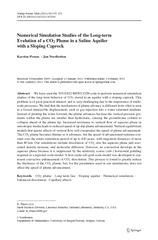| dc.contributor.author | Pruess, Karsten | eng |
| dc.contributor.author | Nordbotten, Jan Martin | eng |
| dc.date.accessioned | 2011-11-23T15:46:43Z | |
| dc.date.available | 2011-11-23T15:46:43Z | |
| dc.date.issued | 2011-02-02 | eng |
| dc.identifier.issn | 0169-3913 | en_US |
| dc.identifier.uri | https://hdl.handle.net/1956/5230 | |
| dc.description.abstract | We have used the TOUGH2-MP/ECO2N code to perform numerical simulation studies of the long-term behavior of CO2 stored in an aquifer with a sloping caprock. This problem is of great practical interest, and is very challenging due to the importance of multiscale processes.We find that the mechanism of plume advance is different from what is seen in a forced immiscible displacement, such as gas injection into a water-saturated medium. Instead of pushing the water forward, the plume advances because the vertical pressure gradients within the plume are smaller than hydrostatic, causing the groundwater column to collapse ahead of the plume tip. Increased resistance to vertical flow of aqueous phase in anisotropic media leads to reduced speed of up-dip plume advancement. Vertical equilibrium models that ignore effects of vertical flow will overpredict the speed of plume advancement. The CO2 plume becomes thinner as it advances, but the speed of advancement remains constant over the entire simulation period of up to 400 years, with migration distances of more than 80 km. Our simulations include dissolution of CO2 into the aqueous phase and associated density increase, and molecular diffusion. However, no convection develops in the aqueous phase because it is suppressed by the relatively coarse (sub-) horizontal gridding required in a regional-scale model. A first crude sub-grid-scale model was developed to represent convective enhancement of CO2 dissolution. This process is found to greatly reduce the thickness of the CO2 plume, but, for the parameters used in our simulations, does not affect the speed of plume advancement. | en_US |
| dc.language.iso | eng | eng |
| dc.publisher | Springer | en_US |
| dc.rights | Creative Commons Attribution Noncommercial License | |
| dc.rights.uri | https://creativecommons.org/licenses/by-nc/2.0 | eng |
| dc.subject | Sloping aquifer | eng |
| dc.subject | Capillary effects | eng |
| dc.subject | CO2 plume | eng |
| dc.title | Numerical Simulation Studies of the Long-term Evolution of a CO2 Plume in a Saline Aquifer with a Sloping Caprock | en_US |
| dc.type | Peer reviewed | |
| dc.type | Journal article | |
| dc.description.version | publishedVersion | en_US |
| dc.rights.holder | Copyright the Author(s) 2011 | en_US |
| dc.identifier.doi | https://doi.org/10.1007/s11242-011-9729-6 | |
| dc.identifier.cristin | 880134 | |
| dc.source.journal | Transport in Porous Media | |
| dc.source.pagenumber | 135-151 | |
| dc.subject.nsi | VDP::Mathematics and natural science: 400::Zoology and botany: 480::Marine biology: 497 | en_US |
| dc.identifier.citation | Transport in Porous Media 90(1): 135-151 | |
| dc.source.volume | 90 | |

